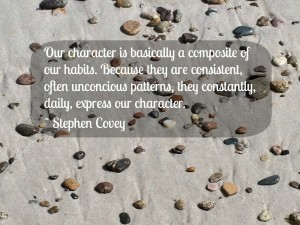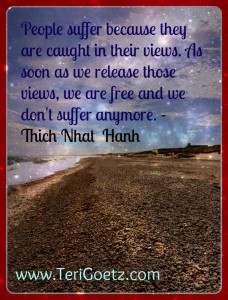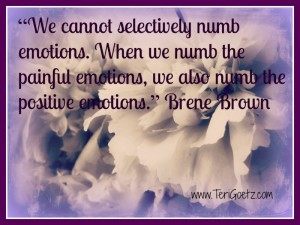You have behaviors that you know you want to change. You call up your willpower reserves and promise that this time you’re going to make the change. You alter your  behavior for a short period of time. Then, either something happens to trigger an old feeling or habit of “I can’t do this” or “What the heck…just this once” and before you know it, you’re on the slippery slope into old behavior. And then what? You feel lousy about yourself.
behavior for a short period of time. Then, either something happens to trigger an old feeling or habit of “I can’t do this” or “What the heck…just this once” and before you know it, you’re on the slippery slope into old behavior. And then what? You feel lousy about yourself.
So at that point there is one more “failure” to add to your pile of “failures.” This additional “failure” further imprints your belief about yourself with yet more proof that in fact, you can’t change. (Remember, a belief is simply thoughts put together and repeated until they become a belief.)
The problem is that it takes more than simply willpower—like everything, it’s a multi-faceted mind/body/spirit thang that’s gotta be happenin’. In my opinion, there are several things (aka “thangs”) that need to happen, and then, most importantly, you need to reinforce the new behavior until it becomes the default habit.
For clarity, these steps are “The Five Ds”:
- Decide you have a belief about yourself that you want to change. (For example, I’m unlovable, I can’t change, or I can’t stop eating.) You can’t just wish it away. A wish and a decision are two different animals. You will notice the difference if you try to make a decision, and then “feel” a wish.
- Dedicate yourself to a mind, body, and spirit approach to change the belief. Change cannot just happen in the head. All parts of you need to be on board.
- Discern which habitual, specific behaviors and feelings feed the belief about yourself that you want to undo (see below).
- Determine
- exactly which emotion you are feeling (for example, unlovable, unworthy, fearful…).
- which behaviors are signals that you are in, or operating from, that subconscious unhealthy belief (for example, I become easily distracted, I start replaying old “hurts” or events in my mind, I feel hungry although I’ve just eaten).
- how you feel physically or emotionally when you experience that belief (for example, I’m so tired, I have a stomachache/headache, my neck is so tight, I’m just sad, there’s a weight on my chest….)
5. Drill new behaviors until they become the habituated response (thus replacing the old behavior of which you were previously unaware).
There are any number of tactics that can be employed. I review different strategies in my blog posts. You can peruse them here on the website going backward in time from this post.
Today, try this:
Begin to identify which behaviors have become your “default mode.” Look for behaviors that do one of two things. They may work as distractions from useful and honest emotions that will trigger your understanding of what habits of thinking or behaving you’ve fallen into. Example: If you feel unlovable, you may compulsively give yourself away to others, in the hope of “winning” their approval and love, until you are losing even more of yourself. You are so busy caretaking, you don’t have time to realize how you feel. Or, your behaviors may simply reinforce your belief about yourself. Using the example above, if you feel unlovable, you may shut people out, rebuff gestures of love and friendship, or even snap at well-meaning individuals, thus “proving” you were right all along… you are not loveable.
I’ll give you an example of what I experience. When I find myself easily distracted from my task at hand (I’ll check email, hear my phone ding and look at it, take a phone call I shouldn’t pick up, play with the dog) I know that I’m in avoidance mode just when I should be getting something important done. I have to consciously pull myself back to my task, and say, “Oh, isn’t that interesting? There’s that behavior that wants to distract me from getting this done.” I do my very best not to judge myself for the behavior. Instead, I just notice it and use it as a cue that I’m in an old belief mode. Why do I sabotage myself? Is it to prove an old belief that I’m “unfocused and distractible?” At that point, I need to love myself back into following through on what I really want — not what my subconscious wants.
It’s important to realize that changing old patterns and behaviors is not an overnight process. It’s not as simple as just having the desire and willpower—you must also do the work. That is, the drills, to change the patterns, to interrupt that “feedback loop” I wrote about last week (i.e., that your emotions feed your thoughts, your thoughts create chemicals that go through your body and create emotions and then it becomes a vicious cycle.) You must interrupt that cycle repeatedly so that you catch yourself quicker and quicker, until the new way becomes your default.
And, there’s nothing wrong with you that your willpower isn’t strong enough to follow through. You’ve become hard-wired to behave this way—and you need to re-wire with the 5 Ds!
Admittedly, there are some really entrenched behaviors or habits that require fairly constant vigilance. However, when you learn to identify the behavior in as objective a manner as possible, it takes the charge off of it. In other words it is neutralized—self-judgment dissipates. By taking the charge off of it, you simply observe then pivot your focus and behavior.
If you’d like more help with any of this, give me a shout and let’s have a conversation. The 5 Ds are an important strategy that I employ in my coaching to help clients make truly quantum leaps in their lives and businesses.
 not good enough, smart enough, young or thin enough are really based on false beliefs which have become fears. (Remember a belief is just a thought you have over and over again.) These fears cast a pall on your light. To shed these thoughts takes courage, but once you do, the reward is true personal freedom. It’s like taking a breath after being underwater for a long time. I promise. It’s refreshing and delicious.
not good enough, smart enough, young or thin enough are really based on false beliefs which have become fears. (Remember a belief is just a thought you have over and over again.) These fears cast a pall on your light. To shed these thoughts takes courage, but once you do, the reward is true personal freedom. It’s like taking a breath after being underwater for a long time. I promise. It’s refreshing and delicious.


